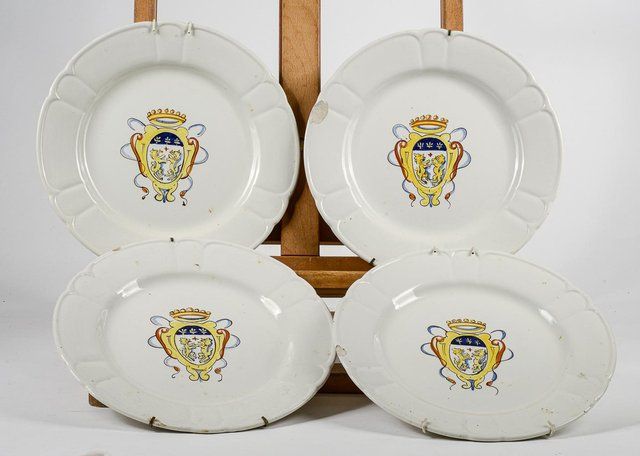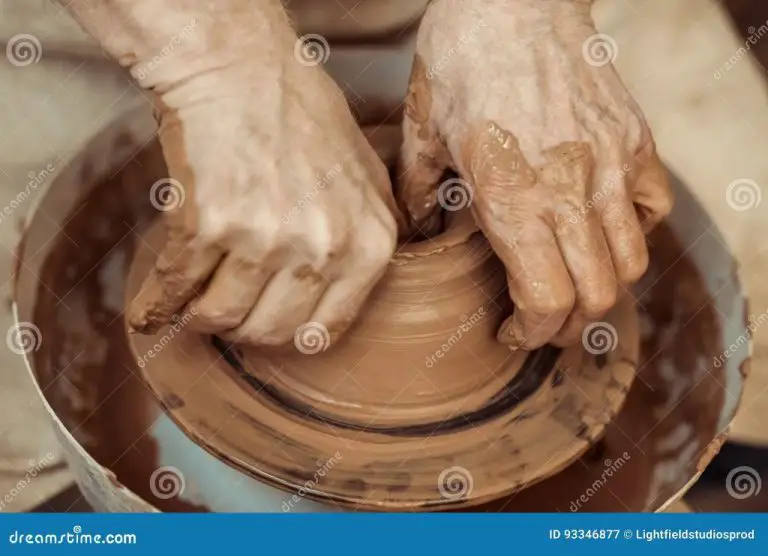What Is The History Of Mancioli Pottery?
Mancioli pottery refers to the ceramics produced by Natale Mancioli’s pottery company based in Montelupo Fiorentino, Italy. The company originated in 1946 when Mancioli founded it in the town, which had a long history of pottery production. Mancioli pottery became known for its colorful glazes and modernist styles, especially during the postwar period in the mid-20th century.
Origins
Mancioli Pottery was founded in the early 19th century by Giovanni Mancioli in the town of Deruta, Italy, which was known for its pottery tradition. Giovanni came from a family of ceramic artists and was inspired to start his own pottery studio after apprenticing under his uncle, who was an acclaimed maestro in Majolica-style pottery. Deruta had been a center of ceramic production since the Middle Ages and Giovanni drew upon the rich artistic history and techniques of the region. He established a small workshop in 1808 and began producing tin-glazed earthenware with vibrant decorations, which became recognizable as the Mancioli style.
Early Years
The Mancioli pottery workshop was founded in the mid-1700s by Giuseppe Mancioli in a small town outside of Florence, Italy. In the early years, production was very limited, with only Giuseppe and a few assistants creating traditional Italian Maiolica style pottery and tiles.
The pottery was made from local clays and decorated with colorful enamel glazes. Designs featured typical Italian motifs like vines, grapes, medallions, and coats of arms. Pieces were primarily functional wares like plates, bowls, jugs, and wall tiles.
Distribution was very localized, with pottery sold in Florence and a few surrounding towns. Transporting fragile wares over long distances was difficult at the time. The small-scale workshop struggled to make ends meet in the very competitive Italian ceramics market.
However, Giuseppe Mancioli persevered, steadily improving his skills and expanding his clientele among the rising merchant class in Florence. The early Mancioli pottery provides a glimpse of the humble beginnings of what would eventually become a thriving international enterprise.
Growth & Expansion
In the early 1900s, Mancioli pottery experienced rapid growth and expansion. The company widened its production and sales reach across Italy and began exporting pieces internationally to Europe and the Americas. According to https://pottery-english.com/mancioli-pottery-history-and-marks/, by the 1920s, Mancioli pottery was being sold in upscale department stores in major cities across the US and Europe.
Mancioli introduced innovative new lines of pottery during this growth period. According to https://markhillpublishing.com/who-what-was-raymor/, they partnered with famous designers to release Art Deco and Mid-Century Modern styles. Key successes included the launch of their Siena line of hand-painted dinnerware and expansion into artful figurines. Mancioli pieces from this era were prized for their high quality and artistry.
Artistic Development
The artistic development of Mancioli pottery over the years reflects evolving styles and influences. In the early 20th century, Mancioli designers were inspired by Art Nouveau and its organic, asymmetrical forms. Intricate floral motifs and curved silhouettes were common. By the 1930s and 40s, Art Deco geometric patterns and bold colors became fashionable. Mid-century Mancioli embraced simpler, more minimalist shapes inspired by modernism.
Some of Mancioli’s most notable artists and designers over the decades include Giuseppe Rossi, famed for his iridescent glazes; Elisa Bertoni, known for her nature-inspired patterns; and Luca Fabbri, who pioneered Mancioli’s sleek, modern aesthetic in the 1960s. The next generation of designers continued innovating with new styles, materials, and techniques while still maintaining the quality craftsmanship Mancioli is known for.
Manufacturing

The manufacturing process for Mancioli pottery was highly specialized and artisanal. Each piece was handmade by master craftsmen using techniques that had been passed down through generations.
The clay used was a special mineral-rich variety sourced locally in the regions of Tuscany where Mancioli operated. It was prepared meticulously by kneading and weathering to achieve the optimal consistency and workability.
Shaping of vessels was done with a combination of wheel throwing, hand molding, and coil building depending on the size and style of the piece. Complex decorative elements were constructed separately then affixed through slip and score attachment.
Glazes were created from scratch by mixing metal oxides, minerals, and other ingredients to achieve the wide array of colors and textures Mancioli was known for. The recipes for the glazes were closely guarded studio secrets.
Firing of the pottery involved multiple stages in wood-burning kilns. Bisque firing hardened the clay before glazing. A series of glaze firings followed to melt and fuse the glazes, culminating in the high temperatures needed for Mancioli’s signature jewel-tones.
Mancioli maintained small workshops clustered around key clay sources. Only a handful of highly trusted artisans worked in each one under the founder’s strict supervision. This ensured the consistent quality and distinctive style for which Mancioli was renowned.
Business Side
The business side of Mancioli pottery has seen its fair share of changes and developments over the years. The small family workshop grew into a larger operation that eventually saw ownership changes. In the late 1930s, the Mancioli brothers brought in outside investors to help expand and market their pottery more widely. This allowed them to increase production and extend their sales channels beyond the local markets.
By the 1950s, the Mancioli brand was being marketed nationally in the United States. They targeted department stores and specialty gift shops with their colorful, handcrafted designs. Sales representatives helped bring their pottery to new audiences across the country. As the brand grew, ownership changed hands multiple times with various business partners and investors getting involved.
Today Mancioli is marketed globally, with exports to retailers around the world. They have maintained the handmade artistic quality of their pottery while scaling up operations. Marketing and branding has been key to their success, by highlighting the tradition and story behind each piece. The business side has adapted over the years to make Mancioli a household name while still producing unique, high-quality ceramic art.
Legacy
Mancioli pottery has left an enduring legacy and continues to captivate collectors and art enthusiasts today. Founded in the early 1900s, Mancioli became renowned for its high-quality ceramics and innovative designs, establishing itself as a premier Italian pottery brand. Even decades after production ceased in the late 1960s, Mancioli maintains an eminent status in the world of ceramic arts.
Mancioli pieces can be found in prestigious museum collections worldwide, including the Metropolitan Museum of Art, the Victoria and Albert Museum, and the Museum of Fine Arts in Boston. These institutions recognize the historical significance and artistic merit of Mancioli pottery by preserving select works for posterity. Auction houses like Christie’s and Sotheby’s regularly feature Mancioli works, confirming the brand’s collectibility and value on the secondary market.
While no longer in operation today, the legacy of the Mancioli pottery studio continues through its timeless wares. Its innovative designs and superlative craftsmanship represent milestones in 20th century ceramic production. Mancioli maintains an enduring prestige that secures its place among the great Italian pottery manufactories of the modern era.
Notable Pieces
Mancioli pottery has produced many famous and iconic works over the years that are highly sought after by collectors and museums alike. Some of their most notable pieces include:
The Mancioli Charger Set decorated with cobalt blue floral motifs against a white background was auctioned by Christie’s for over $150,000 in 2010, setting a record for Mancioli ceramics.
The Metropolitan Museum of Art has several remarkable examples of Mancioli pottery in their permanent collection, including a 19th century vase with octopus handles and a charger featuring Renaissance-style figural scenes.
Sotheby’s previously sold a rare Mancioli majolica humidor from the late 19th century for $85,000. It featured intricate relief modeling and vibrant multicolor glazes in the istoriato style.
In 2006, Doyle New York auctioned a Mancioli pottery plaque with a relief portrait of a nobleman for $145,000. The vibrant cobalt, green and yellow colors on a pristine white background showed the superb artistry of the Mancioli painters.
Christie’s sold an early 20th century Mancioli vase decorated with birds and flowers for over $100,000 in 2008. Its large size and exceptional condition made it a top collecting trophy.
Conclusion
In conclusion, Mancioli pottery has an illustrious history spanning nearly two centuries. Founded in the early 1800s by Giovanni Mancioli in Faenza, Italy, it grew from a small workshop into an internationally renowned brand known for its high-quality craftsmanship and artistry. Though the company faced challenges due to world wars and economic downturns, it persevered and continued producing beautiful works of pottery that are still prized by collectors today.
Looking to the future, Mancioli pottery will likely continue to be coveted by ceramics aficionados around the world. As long as the company maintains its commitment to skilled artisans producing handmade works, Mancioli will remain an important part of Italy’s pottery legacy. The story of the Mancioli pottery workshop illustrates how dedication to tradition and quality can allow an artisanal craft to thrive over generations.
Mancioli’s history matters because it represents a vital tradition of Italian ceramic artistry. By studying revered pottery brands like Mancioli, we can better appreciate the cultural impact and continued relevance of this ancient art form. As fashions come and go, Mancioli endures as a testament to the transcendent appeal of expertly wrought clay.



